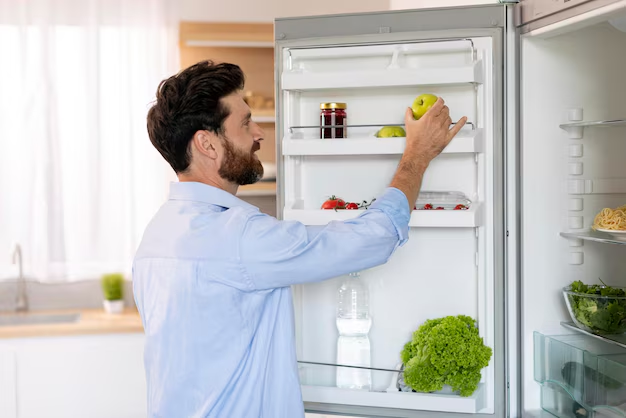Effortlessly Defrost Your Refrigerator’s Evaporator Coils: A Practical Guide
Refrigerators are essential for keeping our food fresh and safe, but issues like frost build-up can compromise their efficiency. One of the most common problems in this category is the freezing of evaporator coils, which can lead to inefficient cooling and a whole host of problems. If you've noticed that your refrigerator isn't as cold as it used to be, the evaporator coils might be to blame. This guide will walk you through how to defrost evaporator coils efficiently and safely, ensuring your fridge runs smoothly and your food stays fresh.
🤔 Why Evaporator Coils Freeze Up
Before diving into the defrosting process, it's helpful to understand why evaporator coils freeze in the first place. The primary purpose of the evaporator coils is to absorb heat from the refrigerator's interior. They work with refrigerant fluid to remove heat, making the inside of your fridge cold. However, when moisture contacts these coils, it can freeze, leading to frost build-up over time.
Common causes include:
- Humidity: High moisture levels inside the refrigerator can lead to more frost.
- Frequent Door Opening: Keeping the door open often brings warm, moist air inside.
- Leaky Gaskets: Damaged door seals allow air exchange that can introduce moisture.
- Low Refrigerant Levels: Inadequate refrigerant affects cooling efficiency and leads to freezing.
Understanding these causes can help prevent future issues after you've defrosted your coils.
🛠 Tools and Safety Considerations
Defrosting evaporator coils doesn't require specialized tools, but there are some items you'll need:
- Hair Dryer or Heat Gun: For quick and even defrosting.
- Towels and Sponges: To soak up any water.
- Bucket or Tray: To collect melted water.
- Screwdriver or Nut Driver: For accessing the coils.
Safety First: Always unplug the refrigerator before beginning any cleaning or repairs to avoid electrical hazards. Additionally, if using a hairdryer, take care not to overheat the coils, which may damage them.
📋 Step-by-Step Defrosting Process
Defrosting your refrigerator’s evaporator coils can be done in several stages for safety and efficiency:
Step 1: Unplug and Empty the Fridge
- Power Down: Unplug your refrigerator to ensure there is no power running to the unit.
- Clear Contents: Remove all food and store it in a cooler or other refrigerator if possible, to prevent spoilage while you work.
Step 2: Access the Evaporator Coils
- Locate the Coil Cover: Typically, the coils are located behind a panel in the freezer section. Use a screwdriver or nut driver to take off this panel.
Step 3: Begin Defrosting
- Use a Hair Dryer: Set the dryer to a low heat setting and gently wave it over the frozen coils to melt away the ice. Be patient and avoid concentrating the heat too long on one spot.
- Natural Thaw: If you prefer a more passive approach, leave the freezer door open and allow the ice to melt naturally. It takes longer but is easier on the coils.
Step 4: Clean and Dry the Area
- Absorb Water: Use towels and sponges to dry up any water that results from the melting ice. Ensure all moisture is removed to prevent refreezing.
Step 5: Reassemble and Plug Back In
- Reattach the Coil Cover: Once the coils are entirely clear of frost, replace the panel and screws.
- Restart the Fridge: Plug your refrigerator back in, allow it to reach its standard temperature, and return your food.
🌟 Preventive Measures for the Future
Once you've tackled the current issue, consider these strategies to prevent future coil freeze-ups:
- Check Door Seals: Regularly inspect and replace door gaskets if they're worn out.
- Reduce Door Openings: Encourage household members to open the fridge only when necessary.
- Routine Maintenance: Schedule regular servicing to check refrigerant levels and other mechanical features.
- Use Defrost Timers: Some modern fridges have automated defrost cycles. Ensure these are functioning correctly.
🚨 Troubleshooting Common Issues
Even after defrosting, some issues may persist. Here are some other things to check:
- Temperature Settings: Ensure your fridge is set to the recommended temperature (usually around 37°F for the refrigerator and 0°F for the freezer).
- Air Flow: Make sure there's enough space between items so airflow isn't blocked.
- Defrost Timer Settings: If your fridge has one and it's malfunctioning, it might need replacement.
✨ Quick Reference Summary
To make it easier, here is a quick summary to refer back to:
Quick Steps: Defrosting Evaporator Coils 🚀
- Unplug & Empty: Safety first, move perishables to an alternative cooling method.
- Access Coils: Remove any coverings to reach the coils.
- Defrost: Use a hairdryer or let it naturally thaw.
- Dry Thoroughly: Prevent moisture from refreezing.
- Reassemble & Restart: Ensure everything is dry and secure before plugging back in.
Key Preventive Tips 🛡️
- Keep fridge doors sealed tight.
- Minimize door-open frequency.
- Regularly check and maintain appliance parts.
- Use defrost timers effectively.
Armed with this guide, your refrigerator should stay in peak condition, efficiently preserving your food and reducing energy use. Regular maintenance and vigilance over factors that contribute to frost build-up can save you time, energy, and the hassle of dealing with future issues.
